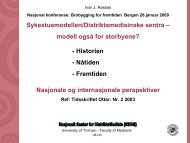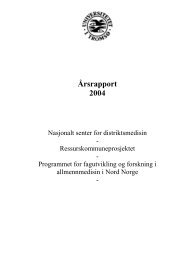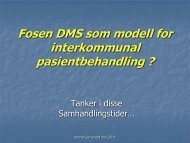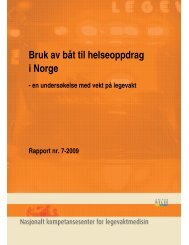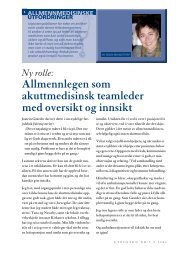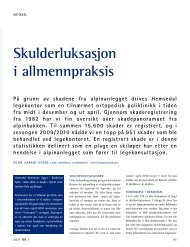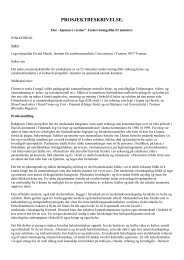Helge Garåsen The Trondheim Model - NSDM
Helge Garåsen The Trondheim Model - NSDM
Helge Garåsen The Trondheim Model - NSDM
You also want an ePaper? Increase the reach of your titles
YUMPU automatically turns print PDFs into web optimized ePapers that Google loves.
trust between the patient and health services while having respect for the individual patient’s<br />
life, integrity and human worth.<br />
<strong>The</strong> patient is entitled to emergency medical services and is entitled to receive necessary<br />
health care from the municipal health service and to receive necessary health care from the<br />
specialist health service. <strong>The</strong> health service must give anyone who applies for, or who needs<br />
health care, the medical- and care-related information he will need in order to safeguard his<br />
rights.<br />
<strong>The</strong> right to health care only applies if the patient can be expected to benefit from the health<br />
care, and if the costs are reasonable compared to the expected effect that can be gained from<br />
the proposed medical measures.<br />
<strong>The</strong> patient is entitled to participate in the implementation of his medical care. This includes<br />
the patient’s right to choose between available and medically sound methods of examination<br />
and treatment. Participation must be adapted to the individual patient’s ability to give and<br />
receive information. If the patient is not capable of giving an informed consent, the patient’s<br />
next of kin is entitled to participate on behalf of the patient. However, it is the clinicians that<br />
make the final decisions.<br />
Both the Swedish and Norwegian acts stress that care must, as far as possible, be conducted<br />
and designed in consultation with the patient. However, the Swedish system is still<br />
characterised by professional paternalism (55).<br />
2.4 Where do the patients want to get care?<br />
A study from Denmark (57) compared the older patients’ ADL statuses with where they were<br />
living prior to, and after, being hospitalised. In this study the authors concluded that older<br />
people with a high ability to cope with daily and social activities wanted to stay in their own<br />
homes and have control over their own future. Leland, in his master’s thesis from 2001,<br />
discussed if the possibility, and ability, to live in a person’s own home is an important value<br />
by itself, worth fighting for and if it by itself strengthens older people’s ability to cope (58),<br />
i.e. an important factor according to Antonovsky’s theories about sense of coherence (SOC)<br />
(59).<br />
27



